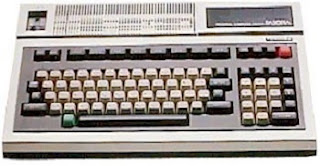The X1 was a surprise product released in 1982 which split from the usual Sharp MZ series of computers released by the computer division. It came from Sharp's TV division with several TV integration features and a modern, stylish design that was available in a range of colours. It was especially endeared by shoot'em up fans.
Like most other computers it did not have a BASIC language built into it's ROM. You had to load it into the computer from tape. This did mean that when not using BASIC there was more RAM free to use for other things.
Although it was outsold by NEC's PC-8801 it was regarded as a better machine because when games were released for both computers the X-1 version was usually superior. Later models improved the screen resolution and colours. It also had some cool exclusive titles of it's own as well. It eventually gave way to the Sharps 16-bit X68000 computer.
SPECIFICATION - Sharp X-1 (1982)
CPU: Z80A @ 4 Mhz
Memory: 6K ROM, 64K RAM, 48K VRAM
Screen Resolution Modes:
320 x 200, 640 x 200, 8 Colours
Sound: Programmable Sound Generator, 3 Channels
OS: CP/M
Here are thirty great games, in alphabetical order, that you can play on
the Sharp X-1. If you wish to find out more details about these
games I have provided the original Japanese kanji which you can copy and
paste in any search engine to get even more results. You can also play
these games on a PC using the X-1 emulator found here
American Truck (Telenet 1985)
アメリカントラック
Top down racer. In each stage you have to reach the finish line before you run out of petrol or time. Pick up petrol items whilst avoiding bombs and other vehicles whilst staying on the road.
Aoki Ookami to Shiroki Mejika (Koei 1986)
蒼き狼と白き牝鹿
The first in a series of turn based strategy games set in the Yuan dynasty of China. The first Emporer of which was Genghis Khan. Similar in style to Koei's other strategy series Nobunaga's Ambition. The further three games in the series were released outside of Japan and used the Genghis Khan name in their titles.


















